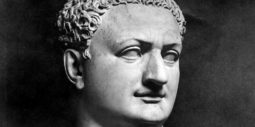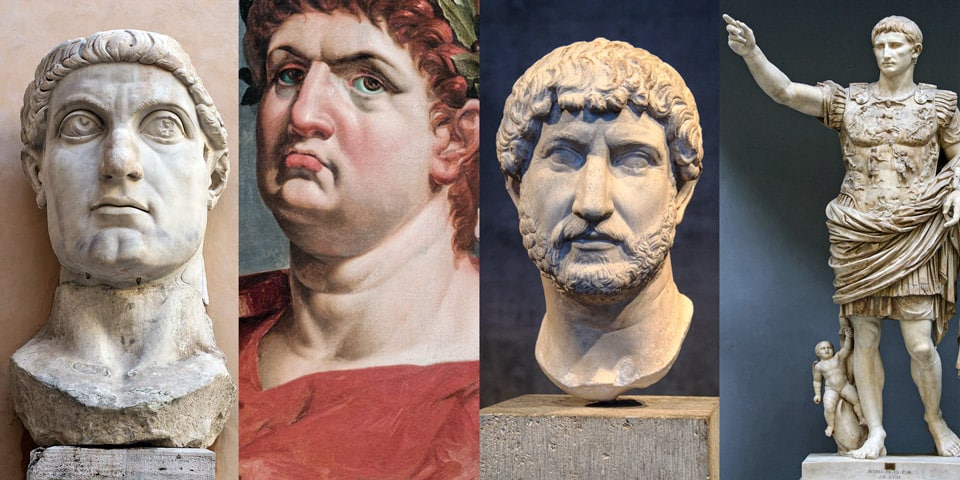
43902 views

Roman Emperors were rulers of the Roman Empire during the imperial period from 27 BC. As a result, they had different titles throughout history. For instance, except “emperor,” early Emperors used the title “princess,” which means “first citizen.”
Moreover, they used republican titles as princeps senatus, consul, and pontifex Maximus. Ancient Roman Emperors controlled the army and were recognized by the Senate. Also, they were usually proclaimed by their troops or invested with imperial titles by the Senate, sometimes both.
The first Roman leaders reigned alone, while later emperors sometimes ruled with co-emperors and divided the administration of the Roman Empire between them. The first Roman Emperor in the history of Roman civilization was Octavian Augustus, while the last Emperor was Romulus Augustulus.
Here’s the list of the most important ancient Roman Emperors:
Contents
Augustus (23 September 63 BC – 19 August 14 AD) was the first ruler of the Roman Empire, who ruled from 27 BC until he died in 14 AD. The original name of the Roman leader was Octavian. Moreover, he was the adopted son of Julius Caesar. After the Second Triumvirate, Octavian came into power. Among representatives of the triumvirate were Mark Antony, Lepidus, and Octavian. Following the death of Caesar, the triumvirate defeated Brutus and Cassius at the Battle of Philippi in 42 BC and decided to split the rule over the republic in three ways.
Antony ruled the east part, Lepidus took Spain and part of North Africa, and Octavian took Italy. The triumvirate broke up in 33 BC, leading to civil war in 31 BC. In the same year, Octavian became an Emperor and took the name “Augustus” (exalted). In 14 AD, Augustus’s stepson Tiberius became Emperor in his place.
Tiberius (16 November 42 BC – 16 March 37 AD) ruled from 14 to 37 AD. He was one of the greatest generals of the Empire, whose campaigns defended the northern frontier. He was considered an excellent ruler during the first half of his reign, but later, he turned into a dark and gloomy ruler. Most probably, the reason for his behavior was the death of his son Drusus at 23, after which the Emperor ended in terror. In 26, Tiberius decided to move to the Isle of Capri and leave an administration in the hands of Praetorian Prefect Sejanus, who became the competent leader of Rome. However, Sejanus also became a conspirator against Tiberius and murdered people who opposed him. When Tiberius recognized it, he removed Sejanus from his position and executed him.
Caligula (31 August 12 AD – 24 January 41 AD) ruled from 37 AD. However, after four years of his reign, he was assassinated by members of his bodyguard and the Roman Senate. He became a famous Emperor since, during his reign, many innocent people were killed, but still, he was approved by the Roman citizens of his time. According to the historical facts, Caligula suffered from cruelty and insanity.
He was killing people for his amusement and committed incest with his sisters. Moreover, he was accused of turning the palace into a brothel.
Read about Roman Emperors who were Assassinated.
Claudius (1 August 10 BC – 13 October 54 AD) ruled from 41 AD until he died in 54 AD. He was a relative of emperors Augustus and Tiberius. Also, Caligula was his nephew, and Mark Antony, his maternal grandfather. People remembered Claudius as a person with disabilities in speech and walking. Moreover, his family kept him away from the public until he was 38 so that enemies did not consider him a serious threat. Claudius was proclaimed Emperor because Caligula’s family was the last adult male. However, he showed excellent administrator and builder of public works skills. The Empire was expanded under his reign. The Emperor was married four times, but none of the marriages ended well. He was succeeded by his adopted son Nero.
Nero (15 December 37 AD – 9 June 68 AD) ruled from 54 AD. Most probably, Nero’s previous Emperor and step-father was assassinated by Nero’s mother, Agrippina the Younger, to make her son the ruler since Claudius’ natural son could gain power. The Emperor improved diplomacy and trade, commissioned the building of theaters, and promoted athletic games. However, in 64 AD, most of Rome was destroyed because of the Great Fire of Rome. The Emperor accused Christians of the fire and started to persecute them. Thus, the Circus of Nero is also known as the place of most early Christians’ burial, where today, the Basilica of Saint Peter is located.
Vespasian (17 November 9 AD – 24 June 79 AD) ruled from 69 AD until 79 AD. He found the Flavian dynasty that ruled for 27 years. During the conqueror of Jerusalem and the Jewish rebellion where Vespasian took place, emperor Nero committed suicide, which led to the civil war in Rome known as the Year of the Four Emperors. Galba and Otho died right after coming to rule, and Vitellius became Emperor in 69 AD. However, the Roman legions of Roman Egypt and Judaea declared Vespasian as the Emperor 3 months after Vitellius’s beginning of reign. Vespasian is famous for the building of the Flavian Amphitheatre, known today as the Colosseum. Moreover, he was the Emperor who created a tax for the public baths, following it with the famous phrase: “Money does not stink” (Pecunia non olet)
Titus (30 December 39 AD – 13 September 81 AD) ruled from 79 to 81 AD. He was a representative of the Flavian dynasty, who succeeded his father, Vespasian. Titus was a successful military commander who ended the Jewish rebellion and besieged Jerusalem in 70 AD. Moreover, he destroyed the city and the Second Temple. For this, he received a triumph: the Arch of Titus, located today on the territory of the ancient Roman Forum. As a ruler, Titus is mainly known for completing the Colosseum.
Domitian (24 October 51 AD – 18 September 96 AD) ruled from 81 AD to 96 AD. He was the younger brother of Emperor Titus and the son of Emperor Vespasian. He was a leader of the Roman Empire for 15 years, which was the longest since that of Emperor Tiberius. Domitian was known for strengthening the economy by making the ancient Roman coins valuable. Also, the Emperor expanded the border defenses of the Roman Empire and commissioned the restoration of the damaged parts of Rome. Under his reign, essential wars took place in Britain and Dacia. Moreover, Domitian saw himself as a new Augustus who wanted to lead the Empire to a new era of brilliance by using solid authoritarian characteristics.
Nerva (8 November 30 AD – 27 January 98 AD) ruled from 96 AD to 98AD. His brief leadership was marred by financial instabilities and his inability to assert his authority over the Roman army. Lately, Nerva adopted Trajan, a young and famous general, and became his successor. However, Nerva was considered by historians a wise Emperor. He managed to ensure a peaceful transition of power after death to Trajan, thus creating the Nerva-Antonine dynasty.
Trajan (18 September 53 AD – 8 Augustus 117 AD) ruled from 98 AD to 117 AD. The Senate officially declared him as the optimus princeps or “the best ruler.” Historians claim that he was a successful soldier and Emperor who made impressive military expansion, created extensive public building programs, and implemented social welfare policies. Thus, he became known as the second of the Five Good Emperors. Nowadays, you can admire Trajan’s Forum, Trajan’s Market, and Trajan’s Column in Rome. The Emperor was succeeded by his adopted son Hadrian.
Hadrian (24 January AD 76 – 10 July 138 AD) ruled from 117 AD to 138 AD. The Emperor was unpopular among the elite because he abandoned Trajan’s expansionist policies and territorial gains in Mesopotamia, Assyria, Armenia, and parts of Dacia. Moreover, Hadrian chose to invest in the improvement of stable borders and the unification of the Empire’s citizens. Thus, Hadrian’s Wall was built during his reign and marked the northern limit of Britannia. In addition, Hadrian completed the Pantheon and constructed the Temple of Venus and Roma. Overall, his reign was peaceful, and he died from chronic illness.
Marcus Aurelius (26 April 121 AD – 17 March 180 AD) ruled from 161 AD to 180 AD with his adoptive brother Lucius Verus, until Lucius died in 169 AD and with his son by Faustina, Commodus, from 177 AD. Marcus Aurelius was known as the last one of the Five Good Emperors. Moreover, the Emperor was the practitioner of Stoicism: his writings became known as Mediations and are considered one of the greatest works of philosophy. You can find the column and Equestrian statue of Marcus Aurelius in Rome erected to celebrate his military achievements.
Commodus (31 August 161 – 31 December 192 CE) ruled with his father, Marcus Aurelius, from 177 AD to his father’s death in 180 AD and by himself until 192 AD. He was the youngest consul in the history of the Roman Empire and, lately, the youngest co-emperor with his father. When he was the only Emperor, the Empire was in a period of reduced military conflict compared to the reign of Marcus Aurelius. However, many intrigues and conspiracies still led Commodus to the dictatorial style of reign. The Emperor was assassinated in 192 AD.
Septimius Severus (11 April 145 AD – 4 February 211 AD) ruled from 193 to 211 AD. He was born in the Roman province of Africa. Moreover, Severus first visited Rome around 163 AD during Marcus Aurelius’s reign and Lucius Verus’s reign. In 193 AD, Petrinax, DidiusJulianus, Pescennius Nigger, and Clodius Albinus were murdered, and Septimius Severus has proclaimed Emperor. After his rule, the important buildings left in Rome were the Arch of Septimius Severus, Arch of the Bankers, Baths of Severus, and Septizodium.
Caracalla (4 April 188 AD – 8 April 217 AD) ruled from 198 to 217 AD. He was a representative of the Severan Dynasty and the elder son of Septimius Severus and Julia Domna. After 198 AD, Caracalla was a co-emperor with his father and continued to rule with his brother Geta, Emperor from 209 AD. However, Caracalla murdered Geta later that year and started to reign the Empire as the sole ruler. His rule was marked by domestic instability and invasions from the Germanic population.
Diocletian (22 December 244 AD – 3 December 311 AD) ruled from 284 to 305 AD. He was born in a family of low status and raised in society because of his military achievements, where he became Roman cavalry commander to Emperor Carus. After the death of Carus and his son Numerian, Diocletian has proclaimed Emperor. His leadership stabilized the Empire and marked the end of the Crisis of the Third Century. Moreover, Diocletian expanded and developed the civil and military services of the Empire.
Constantine The Great (27 February 272 AD – 22 May 337 AD) ruled between 306 and 337 AD. He was also known as Constantine I. Moreover, he was the son of Flavius Valerius Constantius and Empress Helena. Constantine was a famous Emperor who developed administrative, financial, social, and military reforms and strengthened the Roman Empire. Moreover, under his reign, Christianity was declared official in 313 AD. One of the most notable constructions left after the Emperor is the Arch of Constantine, located right in front of the Colosseum.
Flavius Romulus Augustulus (460 AD – 507 AD) ruled the Western Roman Empire from 475 to 476 AD. He is described as the last Western Roman Emperor. Moreover, his reign marks the end of Ancient Rome and the beginning of the Middle Ages in Western Europe. Under his rule, the capital of the Empire was Ravenna. However, he was a leader only for ten months. Lately, Odoacer (Germanic foederatus officer) forced him to abdicate.
This website uses cookies. For more info read the cookies policy
Rome.us © 2025. Created with love by Roman experts and guides.